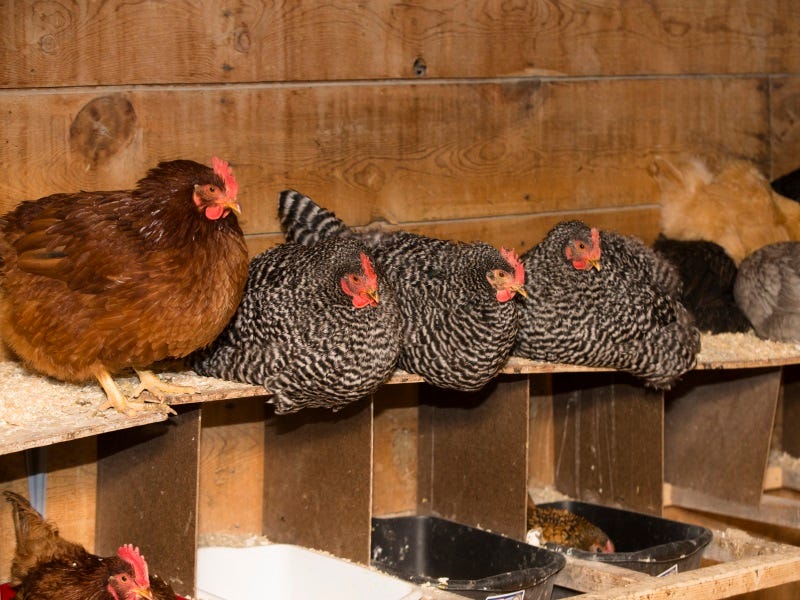How Much Does It Cost to Raise Chickens?

Startup Costs ($60-$90)
Picking up your chicks at a farm store is an exciting day when starting your own home flock, whether that’s in your backyard, in an urban setting, or on a farm. Before that day arrives, however, you need to get your brooder set up and running. The brooder serves as home to your young birds for four-to six weeks and it’s important to get it right because the brooder keeps chicks warm and safe.
Inexpensive chick home starter kits are available for around $25, but large boxes and bins, which you might find around the house, work as well. A heat lamp with a bulb and a spare bulb—in case one burns out—sets you back another $25. Chick feeders and a one-gallon waterer add another $10. A 40-to 50 pound bag of start and grow feed, plus electrolytes you add to the water, costs between $15 and $20 and feeds four or five chicks through week 16. At that time the birds transition to layer feed. Initially, you can line the brooder with newspaper. Once your chicks learn what food looks like you can transition them to pine shavings. A three cubic foot bail of shavings sets you back a little over $5. Get the brooder up and running before you pick up your chicks at the store. That way your chicks come home to a warm and comfortable brooder. Depending on the chicken breed you select most chicks cost between $2 and $5.
Coop Construction ($150-$1000)
Coops are typically the single greatest cost in starting up your own flock. Cost varies widely depending on how big the coop is. In general, you want at least four square feet of space per hen and this space can be divided between the nesting and roosting area, and a protected outdoor run. Pre-made kits are available and run anywhere from $200 to more than $1,000. A lot of people build their own coops and I've seen coops far more luxuriant than my first college apartment. For my coop, I keep it simple using two cattle panels to create a mini-hoop house, to which I add chicken wire and cover in a heavy-duty tarp. The ends are framed, doors added, and it’s covered in hardware cloth to let light and air in while keeping predators out. The whole setup costs less than $150.
Interior Decorating ($100-$150)
Coops need four critical features to keep your hens happy. First, is a place to roost. I use 2x4s with the flat side up. I try and provide two feet of roosting space per hen. This allows the hen to lay down on her feet in the winter and keep them warm. Put roosts higher than the nest boxes as this helps discourage roosting in the nesting box. Nest boxes can be constructed from a variety of materials. I've used five-gallon buckets for daintier breeds but prefer to build or buy larger wooden boxes for more traditional big-bodied heritage breeds. You'll need a nest box for every four hens and expect to spend about $10 per box. Don't go overboard on nest boxes as even 10 or more hens end up squabbling over one or two boxes and ignore the rest. A large, five-gallon, gravity-fed waterer keeps your hens hydrated. I prefer nipple waters like the Little Giant Hen Hydrator, $20, that reduces waste and minimizes evaporation during the summer months. If you live somewhere that freezes in winter you'll need a heated poultry fountain that cost around $40. To finish off the coop you'll need a feeder. Feeders can be made at home from pvc pipe. Or you can buy 14-40 pound galvanized steel feeders that last a lifetime and cost between $15 and $25. The bigger your feeder the less often you will need to refill it. Some people opt to add lights to their coop to extend daylight during the winter months, which keeps egg production up. Any inexpensive lighting setup works, but I do not recommend adding a heat lamp to the coop as it isn't necessary and greatly increases the risk of fire.
Maintenance ($3/month/hen)
Hens consume on average ¼ pound of feed per day, which pencils out to $2 or $3 per month per hen. Less if they are free-ranged. Other costs are minimal as you may opt for supplemental scratch grains or oyster shell that should amount to far less than $1 per bird over a month period. Water and additional electricity consumption for winter lighting and water heaters may add a small but insignificant amount to your utility bills.
Return on Investment
Chickens provide more than a steady supply of fresh eggs with vibrant yolks. Chickens provide a variety of services for the small farm or backyard gardener. They vanquish insects thoroughly from the garden or field, especially problematic species like grasshoppers and slugs. A flock of five hens can level out 400 square feet of tilled soil in a day. They do an exceptional job of turning over leaf piles or compost heaps, helping to break down organic material. Chickens are unrelenting in their pursuit of food, which makes them fun to watch and pass the time. But more importantly they also produce lots of poop. Chicken poop is spectacular garden fertilizer. I know my family's life is so much richer because we keep chickens. Many of our hens are deeply bonded with us and I even have a hen that sneaks under the fence when I arrive at home to meet me at the door. They can be great companions or they are happy to mind their own business as a utilitarian livestock. Either way they are a great investment for any backyard or farm.
